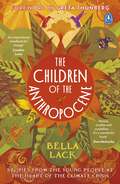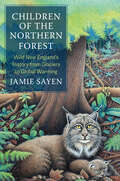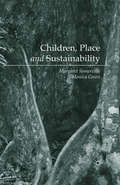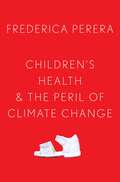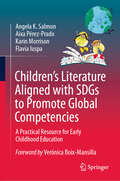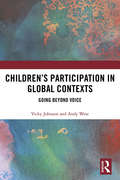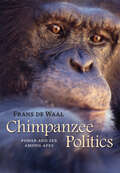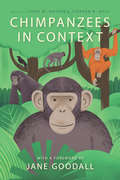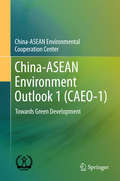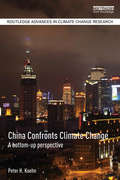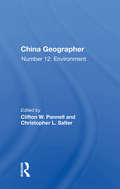- Table View
- List View
The Children of the Anthropocene: Stories from the Young People at the Heart of the Climate Crisis
by Bella Lack'An inspirational manifesto for change' Caroline Lucas, former leader of The Green Party 'A remarkable and important book' Steve Backshall, Naturalist, Broadcaster, and Author'Astute, erudite and crystalline, Bella writes with visionary clarity and passion [...] It's a wonderful book' Dara McAnulty, award-winning author of Diary of a Young Naturalist____________________________Across the planet, the futures of young people hang in the balance as they face the harsh realities of the environmental crisis. Isn't it time we made their voices heard?The Children of the Anthropocene, by conservationist and activist Bella Lack, chronicles the lives of the diverse young people on the frontlines of the environmental crisis around the world, amplifying the voices of those living at the heart of the crisis.Advocating for the protection of both people and the planet, Bella restores the beating heart to global environmental issues, from air pollution to deforestation and overconsumption, by telling the stories of those most directly affected. Transporting us from the humming bounty of Ecuador's Choco Rainforest and the graceful arcs of the Himalayan Mountains, to the windswept plains and vibrant vistas of life in Altiplano, Bella speaks to young activists from around the world including Dara McAnulty, Afroz Shah and Artemisa Xakriabá, and brings the crisis vividly to life.It's time we passed the mic and listened to different perspectives. Bella's manifestos for change will inspire and mobilize you to rediscover the wonders and wilds of nature and, ultimately, change the way you think about our planet in crisis. This is your chance to hear the urgent stories of an endangered species too often overlooked: the children of the Anthropocene. ____________________________'Extraordinarily moving, wild and engaging - the book of the moment' Mary Robinson, Former President of Ireland and author of Climate Justice'A visionary statement for the future [...] Pragmatic, positive & beautifully written' Ben Macdonald, Award-Winning Conservation Writer, Wildlife TV Producer and Naturalist
Children of the Northern Forest: Wild New England's History from Glaciers to Global Warming (Yale Agrarian Studies Series)
by Jamie SayenThis no-holds-barred narrative of the failure of conservation in northern New England’s forests envisions a wilder, more equitable, lower-carbon future for forest-dependent communities Jamie Sayen approaches the story of northern New England’s undeveloped forests from the viewpoints of the previously unheard: the forest and the nonhuman species it sustains, the First Peoples, and, in more recent times, the disenfranchised human voices of the forest, including those of loggers, mill workers, and citizens who, like Henry David Thoreau, wish to speak a kind word for nature. From 1988 to 2016 paper companies sold their timberlands and closed seventeen paper mills in northern New England. Policy makers ceded veto power to large absentee landowners, who tried to preserve the status quo by demanding additional tax cuts and other subsidies for economic elites. They vetoed measures designed to restore and preserve forest health; at present, about half of the former industrial forests are classified as degraded, and the regional economy continues to be trapped in low-value commodity markets. This book operates as a case study of how a rural resource region can respond to a global economy responsible for climate change, habitat loss and degradation, and environmental injustice. Sayen offers a blueprint for restoring vast wildlands and transitioning to a lower-carbon, high-value-adding, local economy, while protecting the natural rights of humans, nonhumans, and unborn generations.
Children, Place and Sustainability
by Margaret Somerville Monica GreenThrough focusing on children's sustainability learning this book examines how school education can address the current environmental problems. It explores children's responses in literacy and language, arts-based approaches, and indigenous studies as well as scientific pedagogies to provide a unique insight into how children learn.
Children's Health and the Peril of Climate Change
by Frederica PereraToday, approximately two billion children breathe toxic air at levels exceeding standards set by the World Health Organization, causing immediate and long-term physical and mental health effects. Nearly every child around the world is at risk from at least one climate-related shock such as severe heat, flooding, drought, air pollution, forest fires, water scarcity, and displacement. Air pollution and climate change, largely driven by emissions from fossil fuel, are widening inequality in children's health. From urban centers in the United States to remote villages in the furthest corners of Asia, we are seeing the effects of our inaction on climate change affecting the next generation--even those still in utero. The global transition away from fossil fuel to a low carbon economy creates a major opportunity for the health and future of our children, but only if we all take action. Children's Health and the Peril of Climate Change brings to light the mental and physical harms to children's health inflicted by climate change and its root cause--our addiction to fossil fuel. Drawing on the author's extensive expertise in children's environmental health, this essential and thought-provoking text exposes the unique vulnerability of the developing child and the multiple and synergistic effects of climate change and air pollution on child health, especially for disadvantaged children. However, it also shows how all children, regardless of their generational wealth or birth country, are imperiled by climate change. While this book provides specific evidence for the escalating dangers of climate change, it also presents a roadmap to a brighter future with case studies of climate change and air pollution policies that have benefitted children's health and the economy. Through facts and compelling storytelling, Frederica Perera shares the growing power of advocacy by youth, environmental justice, and Indigenous groups. She describes the many solutions now available, highlighting the need for integrated climate and social policies to accelerate the transition into a zero-carbon future. Leveraging the universally shared value of protecting children, Children's Health and the Peril of Climate Change is a call to action to replace denial and despair around climate change with purpose and commitment for a healthier, more sustainable future.
Children's Health and the Peril of Climate Change
by Frederica PereraToday, approximately two billion children breathe toxic air at levels exceeding standards set by the World Health Organization, causing immediate and long-term physical and mental health effects. Nearly every child around the world is at risk from at least one climate-related shock such as severe heat, flooding, drought, air pollution, forest fires, water scarcity, and displacement. Air pollution and climate change, largely driven by emissions from fossil fuel, are widening inequality in children's health. From urban centers in the United States to remote villages in the furthest corners of Asia, we are seeing the effects of our inaction on climate change affecting the next generation--even those still in utero. The global transition away from fossil fuel to a low carbon economy creates a major opportunity for the health and future of our children, but only if we all take action. Children's Health and the Peril of Climate Change brings to light the mental and physical harms to children's health inflicted by climate change and its root cause--our addiction to fossil fuel. Drawing on the author's extensive expertise in children's environmental health, this essential and thought-provoking text exposes the unique vulnerability of the developing child and the multiple and synergistic effects of climate change and air pollution on child health, especially for disadvantaged children. However, it also shows how all children, regardless of their generational wealth or birth country, are imperiled by climate change. While this book provides specific evidence for the escalating dangers of climate change, it also presents a roadmap to a brighter future with case studies of climate change and air pollution policies that have benefitted children's health and the economy. Through facts and compelling storytelling, Frederica Perera shares the growing power of advocacy by youth, environmental justice, and Indigenous groups. She describes the many solutions now available, highlighting the need for integrated climate and social policies to accelerate the transition into a zero-carbon future. Leveraging the universally shared value of protecting children, Children's Health and the Peril of Climate Change is a call to action to replace denial and despair around climate change with purpose and commitment for a healthier, more sustainable future.
Children’s Literature Aligned with SDGs to Promote Global Competencies: A Practical Resource for Early Childhood Education
by Angela K. Salmon Aixa Pérez-Prado Karin Morrison Flavia IuspaThis book presents children’s literature as a platform for learning and helping young readers develop the knowledge, skills, and attitudes needed to thrive in an interconnected and diverse global society. It draws from various theoretical frameworks and research findings to implement critical literacy and culturally responsive teaching in the meaning-making process.The book focuses on global competencies and Sustainable Development Goals (SDGs) as intertwined concepts that work together to foster a more sustainable, inclusive, and equitable world. Developing global competencies empowers children and communities to actively participate in achieving the SDGs and addressing the pressing challenges of our time. The authors set high expectations on children as actors in transforming society. To facilitate this, the book offers an overview of child development theories as a foundation for designing developmentally appropriate practices to extend children’s books toward deep thinking and understanding. The book includes sample lessons that use cutting-edge research-based pedagogies and tools such as visible thinking routines and other approaches. Those lessons also help readers identify the Habits of Mind (HOM) children can develop by listening to and discussing stories. The HOM are attributes of good problem-finders and problem-solvers needed when confronting complex issues. The book provides resources and sample lessons that implement different thinking strategies to engage children in questioning and analyzing what they read, making them more critical. This is how children deeply understand the world and their role in creating positive change. The book aims to cultivate change-makers and global citizens through stories. It offers innovative approaches, including online learning options in accessible and engaging ways to help children think globally and act locally‘Through the power of children’s literature, this book serves a larger agenda: To build a more thoughtful world for future generations. By caring for and learning from one another through suggested activities in this book, they will share the riches and resources from across the world. As children learn about the promise of actions toward the UN Sustainable Goals, they can imagine living in an interdependent learning community where all people continually searching for ways to trust each other, learn together, and grow toward greater intelligence.’ Arthur Costa and Bena Kallick, Co-Founders and Directors of The Institute for Habits of Mind
Children’s Participation in Global Contexts: Going Beyond Voice
by Vicky Johnson Andy WestChildren's and young people’s right to participate has been increasingly acknowledged and taken up internationally, as expressed in the UN Convention on the Rights of the Child. Yet much of this has focused on collecting children’s voices, rather than achieving change, and has met its limits. This book provides an analysis of children’s participation in formal, collective and action research processes in six different international settings. It offers a deeper understanding of what helps and facilitates children's and young people’s participation through research, evaluation and decision-making to go beyond voice and effect change. This analysis is set in the context of historical and current discourses of participation, the sociology of childhood, contemporary anthropology, children’s geography and international development. Themes addressed include time and processes in children’s participation, shifting and multiple identities of children, political and cultural contexts, places and spaces children inhabit, skills and capacities of adults, accountability and power. The analysis promotes an approach to children’s participation as relational and collaborative, and will contribute to answering some of the questions facing practitioners and researchers embarking on participatory enquiry with children and young people. This is an invaluable book for practitioners and for scholars, postgraduates in anthropology, sociology, human geography, childhood studies, development studies, social policy, social work, community work, education, youth work and those with an interest in citizenship, children’s rights and human rights. Researchers and practitioners in UN, government and non-government services will also find it applicable to engaging with children and young people.
Children’s Participation in Global Contexts: Going Beyond Voice
by Vicky Johnson Andy WestChildren's and young people’s right to participate has been increasingly acknowledged and taken up internationally, as expressed in the UN Convention on the Rights of the Child. Yet much of this has focused on collecting children’s voices, rather than achieving change, and has met its limits. This book provides an analysis of children’s participation in formal, collective and action research processes in six different international settings. It offers a deeper understanding of what helps and facilitates children's and young people’s participation through research, evaluation and decision-making to go beyond voice and effect change. This analysis is set in the context of historical and current discourses of participation, the sociology of childhood, contemporary anthropology, children’s geography and international development. Themes addressed include time and processes in children’s participation, shifting and multiple identities of children, political and cultural contexts, places and spaces children inhabit, skills and capacities of adults, accountability and power. The analysis promotes an approach to children’s participation as relational and collaborative, and will contribute to answering some of the questions facing practitioners and researchers embarking on participatory enquiry with children and young people. This is an invaluable book for practitioners and for scholars, postgraduates in anthropology, sociology, human geography, childhood studies, development studies, social policy, social work, community work, education, youth work and those with an interest in citizenship, children’s rights and human rights. Researchers and practitioners in UN, government and non-government services will also find it applicable to engaging with children and young people.
Children’s Vegetarian Culture in the Victorian Era: The Juvenile Food Reformers Press and Literary Change (Routledge Environmental Literature, Culture and Media)
by Marzena KubiszThis book fills a unique gap in the research on the cultural history of vegetarianism and veganism, children's literature and Victorian periodicals, and it is the first publication to systematically describe the phenomenon of Victorian children’s vegetarianism and its representations in literature and culture.Situated in the broad socio-literary context spanning the late nineteenth century and early twentieth century, the book lays the groundwork for contemporary children’s vegan literature and argues that present ethical and environmental concerns can be traced back to the Victorian period. Following the current turn in contemporary research on children, their experience and their voices, the author examines children’s vegetarian culture through the prism of the periodicals aimed directly at them. It analyses how vegetarian principles were communicated to children and listens to the voices of children who were vegetarians, and who tested their newly formed identity in the pages of three magazines published between 1893 and 1914: The Daisy Basket, The Children’s Garden and The Children’s Realm. This book will appeal to the growing body of researchers interested in the social, cultural and literary aspects of vegetarianism and veganism, human–animal relations, childhood studies, children’s literature, periodical studies and Victorian studies.
Children’s Vegetarian Culture in the Victorian Era: The Juvenile Food Reformers Press and Literary Change (Routledge Environmental Literature, Culture and Media)
by Marzena KubiszThis book fills a unique gap in the research on the cultural history of vegetarianism and veganism, children's literature and Victorian periodicals, and it is the first publication to systematically describe the phenomenon of Victorian children’s vegetarianism and its representations in literature and culture.Situated in the broad socio-literary context spanning the late nineteenth century and early twentieth century, the book lays the groundwork for contemporary children’s vegan literature and argues that present ethical and environmental concerns can be traced back to the Victorian period. Following the current turn in contemporary research on children, their experience and their voices, the author examines children’s vegetarian culture through the prism of the periodicals aimed directly at them. It analyses how vegetarian principles were communicated to children and listens to the voices of children who were vegetarians, and who tested their newly formed identity in the pages of three magazines published between 1893 and 1914: The Daisy Basket, The Children’s Garden and The Children’s Realm. This book will appeal to the growing body of researchers interested in the social, cultural and literary aspects of vegetarianism and veganism, human–animal relations, childhood studies, children’s literature, periodical studies and Victorian studies.
A Child's Christmas in Wales & Other Stories and Poems (Macmillan Collector's Library)
by Dylan ThomasA beautiful gift for Christmas, this superb selection of writing, by celebrated Welsh poet Dylan Thomas, opens with his enchanting story A Child’s Christmas in Wales. This classic tale recalls magical days full of family, snowy countryside and the magic of Christmas, inspired by the author’s childhood in Wales.Thomas also revisits his youth in his series of stories Portrait of the Artist as a Young Dog. Brilliantly evoking his life through boyhood and adolescence to emerge as a young man in a series of vivid, uncompromising stories peopled with finely drawn characters.Then come the poems, carefully chosen and featuring such greats as ‘And death shall have no dominion’, ‘Fern Hill’ and ‘Do not go gently into that good night’.Dylan Thomas was a twentieth-century bard, and was able to get to the root of people’s lives and to express human emotions with intense skill and originality. He is remembered for his love of words and a startling inventiveness which has yet to be beaten.A Child's Christmas in Wales & Other Stories and Poems is part of the Macmillan Collector’s Library; a series of stunning, pocket-sized classics bound in real cloth with gold foiled edges and ribbon markers. These beautiful books make perfect gifts or a treat for any book lover.
The Chimpanzee & Me
by Ben GarrodBen Garrod: As seen on TV – Baby Chimps Rescue. 'Celebrities blamed for the rise in people keeping primates as pets in Britain' TIMES 2.'4,500 primates owned as pets in the UK' SKY NEWS.'As ownership of exotic pets booms, no wonder experts are asking... conservation or cruelty?' DAILY MAIL. The Chimpanzee & Me is a unique look at conservation of the species and Ben's life-long love of chimps, illustrated with full colour photos. For over a decade, Ben Garrod has studied chimpanzees to find ways to protect and conserve them. We join Ben on a journey that has taken him around the world, studying eastern chimps in the humid forests of Uganda and the critically endangered western chimps of Liberia. In his trademark infectious, lighthearted style, Ben describes encounters with chimpanzees that highlight the different threats they face. From the illegal international pet trade, to bushmeat markets, and the effects of relentless habitat destruction – not to mention how your new furniture, your toothpaste and even your mobile phone are all implicated in their falling numbers. In an interview with world-renowned primatologist Dr Jane Goodall, Ben shows how we can protect the chimps of the future and help conserve this endlessly fascinating species.
Chimpanzee Politics: Power And Sex Among Apes (PDF)
by Frans De WaalThe first edition of Frans de Waal's Chimpanzee Politics was acclaimed not only by primatologists for its scientific achievement but also by politicians, business leaders, and social psychologists for its remarkable insights into the most basic human needs and behaviors. Still considered a classic, this edition is a detailed and thoroughly engrossing account of rivalries and coalitions-actions governed by intelligence rather than instinct. As we watch the chimpanzees of Arnhem behave in ways we recognize from Machiavelli (and from the nightly news), de Waal reminds us again that the roots of politics are older than humanity.
Chimpanzees in Context: A Comparative Perspective on Chimpanzee Behavior, Cognition, Conservation, and Welfare
by Lydia M. Hopper Stephen R. RossThe study of the chimpanzee, one of the human species’ closest relatives, has led scientists to exciting discoveries about evolution, behavior, and cognition over the past half century. In this book, rising and veteran scholars take a fascinating comparative approach to the culture, behavior, and cognition of both wild and captive chimpanzees. By seeking new perspectives in how the chimpanzee compares to other species, the scientists featured offer a richer understanding of the ways in which chimpanzees’ unique experiences shape their behavior. They also demonstrate how different methodologies provide different insights, how various cultural experiences influence our perspectives of chimpanzees, and how different ecologies in which chimpanzees live affect how they express themselves. After a foreword by Jane Goodall, the book features sections that examine chimpanzee life histories and developmental milestones, behavior, methods of study, animal communication, cooperation, communication, and tool use. The book ends with chapters that consider how we can apply contemporary knowledge of chimpanzees to enhance their care and conservation. Collectively, these chapters remind us of the importance of considering the social, ecological, and cognitive context of chimpanzee behavior, and how these contexts shape our comprehension of chimpanzees. Only by leveraging these powerful perspectives do we stand a chance at improving how we understand, care for, and protect this species.
Chimpanzees in Context: A Comparative Perspective on Chimpanzee Behavior, Cognition, Conservation, and Welfare
The study of the chimpanzee, one of the human species’ closest relatives, has led scientists to exciting discoveries about evolution, behavior, and cognition over the past half century. In this book, rising and veteran scholars take a fascinating comparative approach to the culture, behavior, and cognition of both wild and captive chimpanzees. By seeking new perspectives in how the chimpanzee compares to other species, the scientists featured offer a richer understanding of the ways in which chimpanzees’ unique experiences shape their behavior. They also demonstrate how different methodologies provide different insights, how various cultural experiences influence our perspectives of chimpanzees, and how different ecologies in which chimpanzees live affect how they express themselves. After a foreword by Jane Goodall, the book features sections that examine chimpanzee life histories and developmental milestones, behavior, methods of study, animal communication, cooperation, communication, and tool use. The book ends with chapters that consider how we can apply contemporary knowledge of chimpanzees to enhance their care and conservation. Collectively, these chapters remind us of the importance of considering the social, ecological, and cognitive context of chimpanzee behavior, and how these contexts shape our comprehension of chimpanzees. Only by leveraging these powerful perspectives do we stand a chance at improving how we understand, care for, and protect this species.
CHINA & THE GEOPOLITICS OF RARE EARTHS C
by Sophia KalantzakosFeaturing a new foreword that brings the book up to date Rare earths are elements that are found in the Earth's crust, and are vital ingredients for the production of a wide variety of high tech, defense, and green technologies-everything from iPhones and medical technologies to wind turbines, efficiency lighting, smart bombs, and submarines. While they are not particularly "rare" in availability, they are difficult and expensive to mine. Yet, China has managed to gain control over an estimated 97 percent of the rare earth industry since the 1990s through cheap production, high export taxes, and artificial limitations of supply. Rare earths, and China's monopoly over them, became international news after China "unofficially" curtailed exports to Japan, the United States, and Europe in 2010. This embargo followed a collision between Chinese and Japanese boats in the East China Sea, a locus of geopolitical and economic tension between the two countries. Although the World Trade Organization forced China to scrap its restrictions, it still holds a stranglehold over these elements that are so critical to the economic and security interests of the United States and its allies. In this book, Sophia Kalantzakos argues that the 2010 rare earth crisis signaled more than just a trade dispute. Rather, it raises questions about China's use of economic statecraft, and must be regarded as a part of the larger discourse of global power relations. Importantly, she also argues that the failure of political actors in major industrial nations to enact comprehensive and effective policy solutions, or the scientific and business communities to devise sustainable rare earth production outside of China, points to future resource competition. Featuring a new foreword, the paperback edition of China and the Geopolitics of Rare Earths examines the impacts of growing worldwide resource competition and the complexities policymakers face as they develop strategies and responses in an increasingly globalized world.
China and Great Power Responsibility for Climate Change (Rethinking Asia and International Relations)
by Sanna KopraAs American leadership over climate change declines, China has begun to identify itself as a great power by formulating ambitious climate policies. Based on the premise that great powers have unique responsibilities, this book explores how China’s rise to great power status transforms notions of great power responsibility in general and international climate politics in particular. The author looks empirically at the Chinese party-state’s conceptions of state responsibility, discusses the influence of those notions on China’s role in international climate politics, and considers both how China will act out its climate responsibility in the future and the broader implications of these actions. Alongside the argument that the international norm of climate responsibility is an emerging attribute of great power responsibility, Kopra develops a normative framework of great power responsibility to shed new light on the transformations China’s rise will yield and the kind of great power China will prove to be. The book will be of interest to students and scholars of international relations, China studies, foreign policy studies, international organizations, international ethics and environmental politics.
China and Great Power Responsibility for Climate Change (Rethinking Asia and International Relations)
by Sanna KopraAs American leadership over climate change declines, China has begun to identify itself as a great power by formulating ambitious climate policies. Based on the premise that great powers have unique responsibilities, this book explores how China’s rise to great power status transforms notions of great power responsibility in general and international climate politics in particular. The author looks empirically at the Chinese party-state’s conceptions of state responsibility, discusses the influence of those notions on China’s role in international climate politics, and considers both how China will act out its climate responsibility in the future and the broader implications of these actions. Alongside the argument that the international norm of climate responsibility is an emerging attribute of great power responsibility, Kopra develops a normative framework of great power responsibility to shed new light on the transformations China’s rise will yield and the kind of great power China will prove to be. The book will be of interest to students and scholars of international relations, China studies, foreign policy studies, international organizations, international ethics and environmental politics.
China and the Environment: The Green Revolution (Asian Arguments)
by Sam GeallSixteen of the world's 20 most polluted cities are in China. A serious water pollution incident occurs once every two-to-three days. China's breakneck growth causes great concern about its global environmental impacts, as others look to China as a source for possible future solutions to climate change. But how are Chinese people really coming to grips with environmental problems? This book provides access to otherwise unknown stories of environmental activism and forms the first real-life account of China and its environmental tensions.'China and the Environment' provides a unique report on the experiences of participatory politics that have emerged in response to environmental problems, rather than focusing only on macro-level ecological issues and their elite responses. Featuring previously untranslated short interviews, extracts from reports and other translated primary documents, the authors argue that going green in China isn't just about carbon targets and energy policy; China's grassroots green defenders are helping to change the country for the better.
China and the Geopolitics of Rare Earths
by Sophia KalantzakosFeaturing a new foreword that brings the book up to date Rare earths are elements that are found in the Earth's crust, and are vital ingredients for the production of a wide variety of high tech, defense, and green technologies-everything from iPhones and medical technologies to wind turbines, efficiency lighting, smart bombs, and submarines. While they are not particularly "rare" in availability, they are difficult and expensive to mine. Yet, China has managed to gain control over an estimated 97 percent of the rare earth industry since the 1990s through cheap production, high export taxes, and artificial limitations of supply. Rare earths, and China's monopoly over them, became international news after China "unofficially" curtailed exports to Japan, the United States, and Europe in 2010. This embargo followed a collision between Chinese and Japanese boats in the East China Sea, a locus of geopolitical and economic tension between the two countries. Although the World Trade Organization forced China to scrap its restrictions, it still holds a stranglehold over these elements that are so critical to the economic and security interests of the United States and its allies. In this book, Sophia Kalantzakos argues that the 2010 rare earth crisis signaled more than just a trade dispute. Rather, it raises questions about China's use of economic statecraft, and must be regarded as a part of the larger discourse of global power relations. Importantly, she also argues that the failure of political actors in major industrial nations to enact comprehensive and effective policy solutions, or the scientific and business communities to devise sustainable rare earth production outside of China, points to future resource competition. Featuring a new foreword, the paperback edition of China and the Geopolitics of Rare Earths examines the impacts of growing worldwide resource competition and the complexities policymakers face as they develop strategies and responses in an increasingly globalized world.
China-ASEAN Environment Outlook 1 (CAEO-1): Towards Green Development
by China-ASEAN Environmental CooperationThis book presents a comprehensive analysis of the status and progress of China-ASEAN green development and examines the common development issues in China and ASEAN Member States (AMSs). It also explores development trends within the framework of global and regional environmental governance and discusses the approaches towards green development in China and AMSs, offering its own definition of green development and using a “pressure-state-response” (PSR) model to build a framework for assessing green development. The book includes typical policy measures and numerous practices for green development in China and AMSs in the form of tables, figures and boxes. Based on detailed analysis, it argues that the global 2030 Agenda for Sustainable Development brings significant opportunities to China and AMSs, that the ongoing pragmatic cooperation should be further advanced, and that a connection between the Belt and Road Initiative and green ASEAN Community should be established to achieve regional sustainable development. As such it furthers readers’ understanding of environment and development and practical policy advice for promoting China-ASEAN cooperation on environment and green development. Intended for decision makers from the government, business sector, and civil societies who are working to boost green development and China-ASEAN cooperation, it is also a valuable resource for government officials, researchers and non-experts interested in creating a balanced relationship between the environment and development.
China Confronts Climate Change: A bottom-up perspective (Routledge Advances in Climate Change Research)
by Peter H. KoehnChina is an integral actor in any movement that will stabilize the global climate at conditions suited to sustainable development for its own population and for people living around the world. Assessments of China’s climatic-system consequences, impact, and responsibilities need to take into account the strengths, weaknesses, and potential of subnational governments, non-governmental organizations, transnational non-state connections, and the urban populace in reducing greenhouse-gas emissions. A multitude of recent local initiatives that have engaged subnational China in actions that mitigate emissions can be enhanced by powerful framings that appeal to citizen concerns about air pollution and health conditions. China Confronts Climate Change offers the first fully comprehensive account of China’s response to climate change, based on engagement with the global climate governance literature and current debates over responsibility along with specific insights into the Chinese context. Responsible implementation of any overarching climate agreement depends on expanding China’s subnational contributions. To remain fully informed about GHG-emissions mitigation, China watchers and climate-change monitors need to pay close attention to bottom-up developments. The book provides a valuable contemporary resource for students, scholars, and policy leaders at all levels of governance who are concerned with climate change, environmental politics, and sustainable urban development.
China Confronts Climate Change: A bottom-up perspective (Routledge Advances in Climate Change Research)
by Peter H. KoehnChina is an integral actor in any movement that will stabilize the global climate at conditions suited to sustainable development for its own population and for people living around the world. Assessments of China’s climatic-system consequences, impact, and responsibilities need to take into account the strengths, weaknesses, and potential of subnational governments, non-governmental organizations, transnational non-state connections, and the urban populace in reducing greenhouse-gas emissions. A multitude of recent local initiatives that have engaged subnational China in actions that mitigate emissions can be enhanced by powerful framings that appeal to citizen concerns about air pollution and health conditions. China Confronts Climate Change offers the first fully comprehensive account of China’s response to climate change, based on engagement with the global climate governance literature and current debates over responsibility along with specific insights into the Chinese context. Responsible implementation of any overarching climate agreement depends on expanding China’s subnational contributions. To remain fully informed about GHG-emissions mitigation, China watchers and climate-change monitors need to pay close attention to bottom-up developments. The book provides a valuable contemporary resource for students, scholars, and policy leaders at all levels of governance who are concerned with climate change, environmental politics, and sustainable urban development.
China Geographer: No. 12: The Environment
by Clifton W. PannellThis book seeks to promote better understanding of China through improved knowledge of its geography. It presents papers on a variety of environmental topics in China ranging from earthquake hazards to nature preserves. New research techniques and analytical methodologies are also presented.
China Geographer: No. 12: The Environment
by Clifton W. Pannell Christopher L. SalterThis book seeks to promote better understanding of China through improved knowledge of its geography. It presents papers on a variety of environmental topics in China ranging from earthquake hazards to nature preserves. New research techniques and analytical methodologies are also presented.
